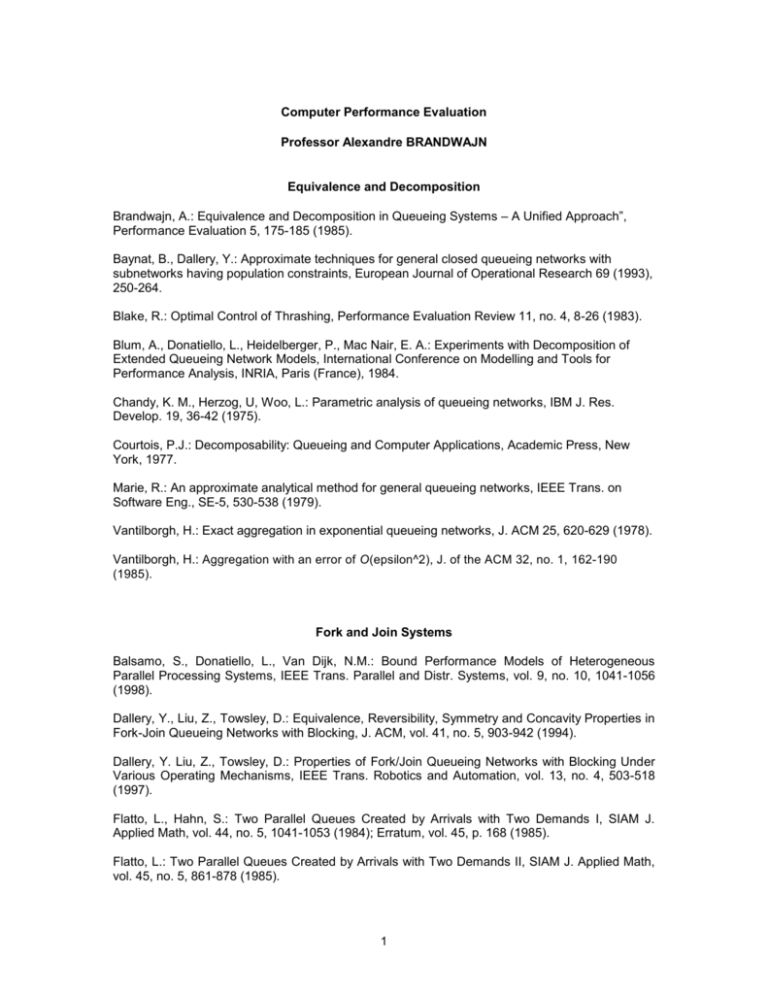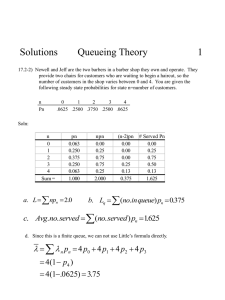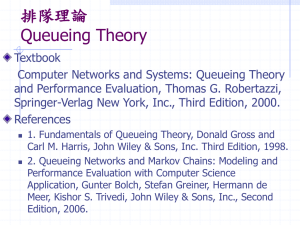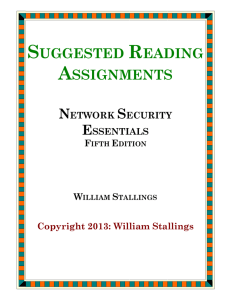Methods and Applications
advertisement

Computer Performance Evaluation Professor Alexandre BRANDWAJN Equivalence and Decomposition Brandwajn, A.: Equivalence and Decomposition in Queueing Systems – A Unified Approach”, Performance Evaluation 5, 175-185 (1985). Baynat, B., Dallery, Y.: Approximate techniques for general closed queueing networks with subnetworks having population constraints, European Journal of Operational Research 69 (1993), 250-264. Blake, R.: Optimal Control of Thrashing, Performance Evaluation Review 11, no. 4, 8-26 (1983). Blum, A., Donatiello, L., Heidelberger, P., Mac Nair, E. A.: Experiments with Decomposition of Extended Queueing Network Models, International Conference on Modelling and Tools for Performance Analysis, INRIA, Paris (France), 1984. Chandy, K. M., Herzog, U, Woo, L.: Parametric analysis of queueing networks, IBM J. Res. Develop. 19, 36-42 (1975). Courtois, P.J.: Decomposability: Queueing and Computer Applications, Academic Press, New York, 1977. Marie, R.: An approximate analytical method for general queueing networks, IEEE Trans. on Software Eng., SE-5, 530-538 (1979). Vantilborgh, H.: Exact aggregation in exponential queueing networks, J. ACM 25, 620-629 (1978). Vantilborgh, H.: Aggregation with an error of O(epsilon^2), J. of the ACM 32, no. 1, 162-190 (1985). Fork and Join Systems Balsamo, S., Donatiello, L., Van Dijk, N.M.: Bound Performance Models of Heterogeneous Parallel Processing Systems, IEEE Trans. Parallel and Distr. Systems, vol. 9, no. 10, 1041-1056 (1998). Dallery, Y., Liu, Z., Towsley, D.: Equivalence, Reversibility, Symmetry and Concavity Properties in Fork-Join Queueing Networks with Blocking, J. ACM, vol. 41, no. 5, 903-942 (1994). Dallery, Y. Liu, Z., Towsley, D.: Properties of Fork/Join Queueing Networks with Blocking Under Various Operating Mechanisms, IEEE Trans. Robotics and Automation, vol. 13, no. 4, 503-518 (1997). Flatto, L., Hahn, S.: Two Parallel Queues Created by Arrivals with Two Demands I, SIAM J. Applied Math, vol. 44, no. 5, 1041-1053 (1984); Erratum, vol. 45, p. 168 (1985). Flatto, L.: Two Parallel Queues Created by Arrivals with Two Demands II, SIAM J. Applied Math, vol. 45, no. 5, 861-878 (1985). 1 Frostig, E., Lehtonen, T.: Stochastic Comparisons for Fork-Join Queues with Exponential Processing Times, J. Appl. Prob., vol. 34, 487-497(1997). Lui, J.C., Muntz, D., Towsley, D.: Computing Performance Bounds of Fork-Join Parallel Programs Under a Multiprocessing Environment, IEEE Trans. Parallel and Distr. Systems, vol. 9, no. 3, 295311 (1998). Thomasian, A., Tantawi, A.N.: Approximate Solutions for M/G/1 Fork/Join Synchronization, Proc. 1994 Winter Simulation Conf., 361-368, Orlando, FL, Dec. 1994. Varki, E.: Mean Value Technique for Closed Fork-Join Networks, Performance Evaluation Review 27, no. 1, 103-112 (1999). Methods and Applications Akyildziz, I. F.: General Closed Queueing Networks with Blocking, 12-th IFIP WG 7.3 International Symposium on Computer Performance, Brussels (Belgium), 1987, 283-303. Balakrishnan, H., Stemm, M., Seshan, S., Katz, R.: Analyzing Stability in Wide-Area Network Performance, Performance Evaluation Review 25, no.1, 2-12 (1997). Buzen, J. P.: Computational Algorithms for Closed Queueing Networks with Exponential Servers, Comm. of the ACM 16, no. 9, 527-531 (1973). Carrasco, J.A., Escriba, J., Calderson, A.: Efficient Exploration of Availability Models Guided by Failure Distances, Performance Evaluation Review 24, no. 1, 242-251 (1996). Chakka, R.: Spectral Expansion Solution for a Finite Capacity Multiserver System in a Markovian Environment, in Proceeding Third International Workshop on Queueing Networks with Finite Capacity, England, 1995. Chame, J., Dubois, M.: Cache Inclusion and Processor Sampling in Multiprocessor Simulations, Performance Evaluation Review 21, no. 1, 36-47 (1993). Chen, S., Towsley, D.: A Performance Evaluation of RAID Architectures, IEEE Transactions on Computers 45, no. 10, 1116-1130 (1996). Cheng, W.C., Muntz, R.R.: Bounding Errors Introduced by Clustering of Customers in Closed Product-Form Queuing Networks, JACM 43, no. 4, 641-669 (1996). Coffman, E.G., Fayolle, G., Mitrani, I.: Two Queues With Alternating Service Periods, in Performance '87, 12th International Symposium on Computer Performance, Brussels, 1987, 227237. Conway, A. E., Georganas, N.D.: Recal, A New Efficient Algorithm for the Exact Analysis of Multiple-Chain Closed Queueing Networks, J. of the ACM 33, no. 4, 768-791 (1986). Conway, A., Pinsky, E., Tridandapani, S.: Efficient Decomposition Methods for the Analysis of Multi-Facility Blocking Models, J. of the ACM 41, no. 4, 648-675 (1994). De Souza e Silva, E., Ochoa, P.M.: State Space Exploration in Markov Models, Performance Evaluation Review no. 20, no. 1, 152-166 (1992). Fayolle, G., Mitrani, I, Iasnogorodski, R.: Sharing a Processor among Many Job Classes, J. of the ACM 27, no. 3, 519-532 (1980). 2 Fayolle, G., Iasnogorodski, R., Malyshev, V.: Random walks in the quarter plane : algebraic methods, boundary value problems, and applications. New York : Springer, 1999. Gong, Wei-Bo, Yang, H.: Rational Approximants for Some Performance Analysis Problems, IEE Transactions on Computers 44, no. 12, 1394-1404 (1995). Greenberg, A. G., Srikant, R.: Computational Techniques for Accurate Performance Evaluation of Multirate, Multihop Communication Networks, Performance Evaluation Review 23, no, 1, 253-260 (1995). Heyman, D.P, Lakshman, T.V., Neidhardt, A. L.: A new Method for Analyzing Feedback-Based Protocols with Applications to Engineering Web Traffic over the Internet, Performance Evaluation Review 25, no.1, 24-38 (1997). Horton, G., Leutenegger, S.T.: A Multi-Level Solution Algorithm for Steady-State Markov Chains, Performance Evaluation Review 22, no. 1, 191-200 (1994). Jacob, B.L., Chen, P.M., Silverman, S.R., Mudge, T.N.: An Analytical Model for Designing Memory Hierarchies, IEEE Transactions on Computers 45, no. 10, 1180-1194 (1996). Kuehn, P.: Analysis of Complex Queueing Networks by Decomposition, 8-th International Teletraffic Congress, Melbourne, 1976, 236-1 - 236-8. Liu, T., Kleinrock, L.: Performance Analysis of Finite-Buffered Multistage Interconnection Networks with a General Traffic Pattern, Performance Evaluation Review 19, no. 1, 68-78 (1991). Lui, J.C.S., Muntz, R.R., Towsley, D.: Balancing Load in a Multi-Server System, IEEE Transactions on Computers 44, no. 12, 1371-1382 (1995). Matta, I., Shankar, A. U.: Z-Iteration: A Simple Method for Throughput Estimation in TimeDependent Multi-Class Systems, Performance Evaluation Review 23, no 1, 126-135 (1995). Meo, M., Marsan, M.A.: Approximate Analytical Models for Dual-Band GSM Networks Design & Planning, IEEE Infocom 2000, 26-30 March 2000, Tel Aviv, Israel. Mitchell, K., Sohraby, K., van de Liefvoort, A., Place, J.: Approximation Models of Wireless Cellular Networks Using Moment Matching, IEEE Infocom 2000, 26-30 March 2000, Tel Aviv, Israel. Mitra, D., Mitrani, I.: Control and Coordination Policies for Systems with Buffers, Performance Evaluation Review 17, no. 1., 156-170 (1989). Muntz, R.R., de Souza e Silva, E., Goyal, A.: Bounding Availability of Repairable Computer Systems, IEEE Trans. on Computers 38, 1714-1723 (1989). Paxson, V.: Empirically derived analytic models of wide-area TCP connections, IEEE/ACM Transactions on Networking 2, 316-336 (1994). Pingali, S., Towsley, D., Kurose, J.F., A Comparison of Sender-Initiated and receiver Initiated Reliable Multicast Protocols, Performance Evaluation Review 22, no. 1, 221-230 (1994). Reiser, M.: Mean Value Analysis of Queueing Networks, a New Look an Old Problem, 4-th International Symposium on Modelling and Performance Evaluation of Computer Systems, Vienna (Austria), 1979. 3 Woodward, M.: Size-Limited Batch Movement in Product-Form Closed Discrete-Time Queueing Networks, Performance Evaluation Review 25, no. 1, 139-146 (1997). Yang, C.L., Kubat, P.: Efficient Computation of Most Probable States for Communication Networks with Multimode Components, IEEE Trans. on Communications 37, 535-538 (1989). Zhang, H., Knightly, E.W.: Providing End-to-End Statistical Performance Guarantees with Bounding Interval Dependent Stochastic Models, Performance Evaluation Review 22, no. 1, 211220 (1994). Priority Queues Blondia, C.: An M/G/1 Finite Capacity Queue with Vacations and Priorities, 12th International Symposium on Computer Performance, December 1987, Brussels, Belgium, 305-325, (1987). Bondi, A., Buzen, J. P.: The Response Times of Priority Classes Under Preemptive Resume in M/G/m Queues, Performance Evaluation Review 12, no. 3, 195-201 (1984). Bondi, A.B., Chuang Y-M.: A New MVA-Based Approximation for Closed Queueing Networks with a Preemptive Priority Server, Performance Evaluation 8, 195-221 (1988). Brandwajn, A., Jow, Yung-li L.: A Note on Service Interruptions, Performance Evaluation Review 13, no. 2, 140-146 (1985). Bryant, R. M., Krzesinski, A. E., Teunissen, P.: The MVA Preempt Resume Approximation, Performance Evaluation Review, Special Issue, August 1983, 12-27. Bunday, B.D., Khorram, E. Bokhari, H.M.: The G/M/r machine interference model with a mixture of priority and ordinary machines, in Proc. Third International Workshop of Queueing Networks with Finite Capacity, July 1995, Ilkley, UK. Chandy, K. M., Lachsmi, M. S.: An Approximation Technique for Queueing Networks with Preemptive Priority Queues, Dept. of Computer Sciences, The University of Texas at Austin, TX 7812, 1982. Eager, D., Lipscomb, J.N.: The AMVA Priority Approximation, Performance Evaluation 9, 173-193 (1988). Epema, D. H. J.: Mean Waiting Times in a General Feedback Queue with Priorities, 14th International Symposium on Computer Performance Modelling, Measurement and Evaluation, Edinburgh (UK), 1990, 221-235. Jaiswal, N.K. and Thiruvengadam: Finite source priority queues, SIAM Journal of Applied Mathematics 15, 1273-1293 (1967). Kameda, H: A finite-source queue with different customers, J. of the ACM 29, 478-491 (1982). Kaufman, J. S.: Approximation Methods for Networks of Queues with Priorities, Performance Evaluation 4, 183-198 (1984). Mitrani, I., King, P.J.B.: Multiprocessor Systems with Preemptive Priorities, Performance Evaluation 1, no. 2, 118-125 (1981). Paterok, M. Fischer, O.: Feedback Queues with Preemption-Distance Priorities, Performance Evaluation Review 17, no. 1, 136-145 (1989). 4 Sevcik, K.: Priority Scheduling Disciplines in Queueing Network Models of Computer Systems, Proc. IFIP Congress 77, North Holland, Amsterdam (1977), 565-570. Snyder, P. M., Stewart, W. J.: An Approximate Numerical Solution for Multiclass Preemptive Priority Queues with General Service Time Distributions, Performance Evaluation Review 13, no. 2, 155-165 (1985). van Doremalen, J.: A Mean Value Analysis of a Closed CP-Terminal System with Preemptive Resume Priorities and General Service Time Distributions, 10th International Symposium on Computer Performance, North Holland, 1984, 535-546. Veran, M.: Exact Analysis of a Priority Queue with Finite Source, International Seminar on Modelling and Performance Evaluation Methodology, Springer Verlag, Berlin, 1984, 371-390. Schmitt, W.: On Decomposition of Markovian Priority Queues and Their Application to the Analysis in Closed Priority Queueing Networks, 10th International Symposium on Computer Performance, North Holland, 1984, 393-407. Maximum Entropy & Catastrophe Theory Kouvatsos, D. D., Tabet-Aouel, N. M.: Product-Form Approximations for an Extended Class of General Closed Queueing Networks, 14th International Symposium on Computer Performance, Measurement and Evaluation, Edinburgh (UK), 1990, 301-315. Kouvatsos, D., Awan, I.-U., Closed queueing networks with repetitive service blocking and multiple job classes, in Proceeding Third International Workshop on Queueing Networks with Finite Capacity, England, 1995. Li, G.-L., Dowd, P.W.: An Analysis of Network Performance Degradation Induced by Workload Fluctuations, IEEE/ACM Transactions on Networking 3, no. 4, 433-440 (1995). Nelson, R.: Stochastic Catastrophe Theory in Computer Performance Modeling, J. of the ACM 34, no. 3, 661-685 (1987). Walstra, R.: Nonexponential Networks of Queues: A Maximum Entropy Analysis, Performance Evaluation Review 13, no. 2, 27-37 (1985). Measurements and Workload Characterization Barford, P., Crovella, M.: Generating Representative Web Workloads for Network and Server Performance Evaluation, Performance Evaluation Review 26, no.1, 151-160 (1998). Brown, A., Seltzer, M.: Operating System Benchmarking in the Wake of Lmbench: A Case Study of the Perofmance of NetBSD on the Intel x86 Architecture, Performance Evaluation Review 25, no. 1, 214-224 (1997). Chen, P.M., Patterson, D.A.: A New Approach to I/O Performance Evaluation-Self-Scaling Benchmarks, Predicted I/O Performance, Performance Evaluation Review 21, no. 1, 1-12 (1993). Crovella, M., Bestavos, A.: Self-Similarity in World Wide Web Traffic, Evidence and Possible Causes, Performance Evaluation Review 24, no. 1, 160-169 (1996). Ferrari, D.: On the Foundations of Artificial Workload Design, Performance Evaluation Review 12, no. 3, 8-26 (1984). 5 Gribble, S.D., Manku, G.S., Roselli, D., Brewer, E.: Self-Similarity in File Systems, Performance Evaluation Review 26, no.1, 141-150 (1998). Heyman, D.P, Lakshman, T.V.: Source Models for VBR Broadcast-Video Traffic, IEEA/ACM Transactions on Networking 4, no. 1, 40-48 (1996). Kaplan, S.F., Smaragdakis, Y., Wilson, P.R.: Trace Reduction for Virtual Memory Simulations, Performance Evaluation Review 27, no. 1, 47-58 (1999). Kerola, T., Schwetman, H.: Monit: A Performance Monitoring Tool for Parallel and PseudoParallelPrograms, Performance Evaluation Review 15, no. 1, 163-174. Krunz, M., Hughes, H.: A Traffic Model for MPEG-Coded VBR Streams, Performance Evaluation Review 23, no. 1, 47-55 (1995). Labovitz, C., Malan, C. R., Jahanian, F.: Internet Routing Instability, Computer Communication Review 27, no. 4, 115-120 (1997). Leland, W.E., Taqqu, M.S., Willinger, W., Wilsons, D.V.: On the self-similar nature of Ethernet traffic, IEEE/ACM Transactions on Networking 2, 1-15 (1994). Lipsky, L.: Modelling Telecommunications Systems That Have Power-tail (Bursty, Chaotic, HeavyTail, Self-Similar, etc) Traffic, in CMG96 Conference, San Diego, December 1996. McNutt, B.: A Simple Statistical Model of Cache Reference Locality, and its Application to Cache Planning, Measurement and Control, in Proceedings CMG91, Nashville 1991, 203-212. Mink, A., Draper, J., Roberts, J.W., Carpenter, R.J.: Hardware-Assisted Multiprocessor Performance Measurement,12-th IFIP WG 7.3 International Symposium on Computer Performance, Brussels (Belgium), 1987, 151-168. Morris, P., Lin, D.: Variance of Aggregated Web Traffic, IEEE Infocom 2000, 26-30 March 2000, Tel Aviv, Israel. Paxson, V.: On Calibrating Measurements of Packet Transit Times, Performance Evaluation Review 26, no. 1, 11-21 (1998). Paxson, V., Floyd, S.: Wide-Area Traffic: The Failure of Poisson Modeling, in Proceedings of SIGCOMM '94, London 1994, 257-268. Samples, A. D.: Mache: No-Loss Trace Compaction, Performance Evaluation Review 17, no. 1, 89-97 (1989). Sang, A., San-qi Li: Predictability Analysis of Network Traffic, IEEE Infocom 2000, 26-30 March 2000, Tel Aviv, Israel. Stunkel, C. B., Fuchs, W. K.: TRAPEDS: Producing Traces for Multicomputers Via Execution Driven Simulation, Performance Evaluation Review 17, no. 1, 70-78 (1989). Whalley, D. B.: Fast Instruction Cache Performance Evaluation Using Compile-Time Analysis, Performance Evaluation Review 20, no. 1, 13-22 (1992). Willinger, W., Taqqu, M.S., Sherman, R., Wilson, D.V.: Self-Similarity Through High-Variability: Statistical Analysis of Ethernet LAN Traffic at the Source Level, IEEE/ACM Transactions of Networking 5, no. 1, 71-86 (1997). 6 Wybranietz, D., Haban, D.: Monitoring and Performance Measuring Distributed Systems During Operation, Performance Evaluation Review 16, no. 1, 197-206 (1988). Miscellaneous Borst, S., Boxma, O., Jelenkovic, P.: Coupled Processors with Regularly Varying Service Times, IEEE Infocom 2000, 26-30 March 2000, Tel Aviv, Israel. Buzen, J.P., Shum, A. W.: A Unified Operational Treatment of RPS Reconnect Delays, Performance Evaluation Review 15, no. 1, 78-92 (1987). Chen, S., Towsley, D.: Performance of a Mirrored Disk in a Real-Time Transaction System, Performance Evaluation Review 19, no. 1, 198-207 (1991). Chiu, D.M., Sudama, R.: A Case Study of DECnet Applications and Protocol Performance, Performance Evaluation Review 16, no. 1, 47-55 (1988). Dan, A., Towsley, D.: An Approximate Analysis of the LRU and FIFO Buffer Replacement Schemes, Performance Evaluation Review 18, no. 1, 143-149 (1990). Denning, P. J., Buzen, J. P.: The Operational Analysis of Queueing Network Models, Computing Surveys 10, 225-241 (1978). Elwalid, A., Heyman, D., Lahsman, T.V., Mitra, D., Weiss, A.: Fundamental Results on the Performance of ATM Multiplexers with Applications to Video Teleconferencing, Performance Evaluation Review 23, no. 1, 86-97 (1995). Franaszek, P.A., Heidelberger, P., Wazlowski, M.: On Management of Free Space in Compressed Memory Systems, Performance Evaluation Review 27, no. 1, 113-121 (1999). Goldschmidt, S. R., Hennessy, J. L.: The Accuracy of Trace-Driven Simulations of Multiprocessors, Performance Evaluation Review 21, no. 1, 146-157 (1993). Koppelman, D.: Congested Banyan Network Analysis Using Congested-Queue States and Neighboring-Queue Effects, IEEE/ACM Transactions on Networking 4, no. 1, 106-111 (1996). Kumar, S., Jian, D., Chandra, R., Sing, J.P.: Evaluating Synchronization on Shared Address Space Multiprocessors: Methodology and Performance, Performance Evaluation Review 27, no. 1, 23-34 (1999). Lazowska, E., Addison, C.: Selecting Parameter Values for Servers of the Phase Type, Performance of Computer Systems, Arato e.a. (eds.), North Holland, 1979, 407-420. Lee, E.K., Katz, R.H.: An Analytic Performance Model of Disk Arrays, Performance Evaluation Review 21, no. 1, 98-109 Melvin, S., Patt, Y.: The Use of Microcode Instrumentation for Development, Debugging and Tuning of Operating System Kernels, Performance Evaluation Review 16, no. 1, 207-214 (1988). Potier, D.: The Markovian Solver of QNAP2 and Examples, International Seminar on Computer Networks and Performance Evaluation, Hasegawa, Takagi, Takahashi (eds.), Tokyo (Japan), 1985, 6.3.1-6.3.21. 7 Rubin, I: Analysis of an M/G/1/N Queue with Vacations and Its Iterative Application to FDDI Timed-Token Rings, IEEE/ACM Transactions on Networking 3, no. 6, 842-856 (1995). Salsburg, M. A.: A Statistical Approach to Computer Performance Modeling, Performance Evaluation Review 15, no. 1, 115-162 (1987). Sanguinetti, J.: Program Optimization for a Pipelined Machine: A Case Study, Performance Evaluation Review 12, no.3, 88-95 (1984). Sevcik, K.: Characterizations of Parallelism in Applications and Their Use In Scheduling, Performance Evaluation Review 17, no. 1., 171-180 (1989). Smaragdakis, Y., Kaplan, S., Wilson, P.: A Simple and Effective Adaptive Page Replacement, Performance Evaluation Review 27, no. 1, 122-133 (1999). Wagner, D. B., Lazowska, E. D., Parallel Simulation of Queueing Networks: Limitations and Potentials, Performance Evaluation Review 17, no. 1, 146-155 (1989). Wolff, R. W.: The Effect of Service Time Regularity on System Performance, Computer Performance, Chandy and Reiser (eds.), North Holland, 1977, 297-304. 8








